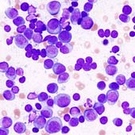Articles tagged with: Extramedullary Disease
News»

Good morning, myeloma world.
We have got quite an eclectic mix of myeloma-related research to report on today, ranging from a couple of lengthy review articles to a short case report.
Speaking of case reports, there are several of them, and we'll start with an unusual one. It's from a group of physicians at a hospital in Milan, Italy. They report on a patient with light chain monoclonal gammopathy who tested positive – incorrectly – on a standard test used to determine if someone regularly drinks a lot of alcohol (abstract). …
News»

A team of Israeli researchers has expressed concern that surgical scars may be a particularly favorable environment for the development of difficult-to-treat extramedullary disease in multiple myeloma patients.
Extramedullary disease occurs when myeloma cells form tumors outside of a patient’s bones.
The Israeli researchers also suggest that novel anti-myeloma therapies –such as thalidomide (Thalomid), Revlimid (lenalidomide), or Velcade (bortezomib) – and perhaps stem cell transplantation may foster the development of extramedullary disease in scar tissue.
The researchers describe their concerns in a recent journal article. In …
Opinion»

Several years ago, well before I had been diagnosed with multiple myeloma, we had a family friend who was diagnosed with an aggressive brain cancer. He was one of these relentlessly upbeat, positive people, and of course, he approached his disease in the same way.
Despite the prognosis and all appearances to the contrary, he refused to accept any outcome except that he was going to “beat this thing.” Now I cannot speak to what he was secretly thinking or what he felt in his heart of hearts, but that was the …
NewsFlash »
Being Overweight At Diagnosis Associated With Better Prognosis In Myeloma – In a recent study using data for U.S. veterans, researchers from Washington University in St. Louis found that the extent to which a multiple myeloma patient is overweight at diagnosis may affect their prognosis. Among the patients studied, those who were more overweight at the time of diagnosis had better prognoses. The researchers used data on each patient's body mass index (BMI) and found that overweight patients (BMI of 25 kg/m2 to 29.9 kg/m2) and obese patients (BMI of 30 kg/m2 or above) had the lowest risk of death compared to healthy-weight patients (BMI of 18.5 kg/m2 to 24.9 kg/m2) and underweight patients (BMI below 18.5 kg/m2). Underweight patients had the highest risk of death. BMI is a measure of how overweight, or underweight, a person is. It is calculated based on a person’s height and weight. The researchers also found that weight loss of 10 percent or more in the year leading up to diagnosis was associated with an increased risk of death. For more information, please see the study in the journal The Oncologist (abstract).
Exposure To Dichloromethane May Increase The Risk Of Developing Myeloma – Results of a recent analysis conducted in China show that occupational exposure to the compound dichloromethane, or methylene chloride, increases the risk of developing multiple myeloma. In particular, people exposed to dichloromethane were twice as likely to develop myeloma as those who were not exposed to dichloromethane. However, the results of the analysis also showed that dichloromethane did not increase the risk for non-Hodgkin’s lymphoma, leukemia, and certain solid tumors, such as breast, lung, and brain cancers. dichloromethane is frequently used as a paint stripper and a degreaser; it has also been used in the food industry. For more information, please refer to the study in Cancer Causes & Control (abstract).
Soft-Tissue Extramedullary Disease Is Associated With Particularly Poor Prognosis – Czech researchers recently found that extramedullary disease that develops in the soft tissue of a myeloma patient is associated with poorer prognosis than extramedullary disease that develops adjacent to a bone. However, both negatively impact overall survival. Extramedullary disease occurs when malignant plasma cells form tumors outside the bone, in organs, soft tissue, or adjacent to bones but outside the bone marrow. Such tumors are more common in relapsed/refractory myeloma patients than in newly diagnosed patients. The Czech researchers analyzed data for 226 relapsed/refractory myeloma patients, 24 percent of whom developed extramedullary disease at relapse. They found that the median time from diagnosis to the development of extramedullary disease was similar, regardless of the type of extramedullary disease (21 months for soft tissue disease and 23 months for disease adjacent to the bone). However, overall survival for patients with extramedullary disease in the soft tissue was 30 months from initial myeloma diagnosis, compared to 45 months for patients with extramedullary disease adjacent to a bone. Overall survival from time of diagnosis for patients without extramedullary disease was 109 months (more than nine years). The researchers point out that extramedullary disease remains one of the major challenges in the care of multiple myeloma patients. For more information, please see the study in Haematologica (pdf).
News»

A recent Greek study highlights the distinct symptoms and disease course of multiple myeloma patients who develop extramedullary disease at relapse.
The results are consistent with those from previous studies and demonstrate that myeloma patients who develop extramedullary disease have poorer overall survival than those who do not. Furthermore, the study investigators identified clinical differences at diagnosis and at relapse between myeloma patients with and without extramedullary disease.
They conclude that myeloma patients with extramedullary disease exhibit a particularly aggressive and treatment-resistant form of myeloma, posing unique therapeutic challenges.
Background And Patient …
News»

A recent study demonstrates that better treatments are still needed for multiple myeloma patients who develop extramedullary disease. Specifically, the results show that these patients have poorer progression-free survival and overall survival compared to patients without extramedullary disease.
The results also show that extramedullary disease is more common in patients with high-risk multiple myeloma.
Extramedullary disease occurs when multiple myeloma cells develop in the soft tissues and organs outside of the bone marrow. It can occur in newly diagnosed myeloma, but it is more commonly found when myeloma relapses (see related
News, Resources»

During the course of their disease, multiple myeloma patients sometimes develop what physicians call either "extramedullary disease," "extramedullary plasmacytomas," or "extramedullary myeloma."
In medicine, when something is described as "extramedullary," it means it is located outside of the bone marrow.
So "extramedullary" myeloma is myeloma that is outside of the bone marrow.
It occurs when malignant plasma cells collect together and form tumors in parts of the body other than a patient's bones.
This can occur in any myeloma patient, but it appears to be more common in patients with relapsed or …
